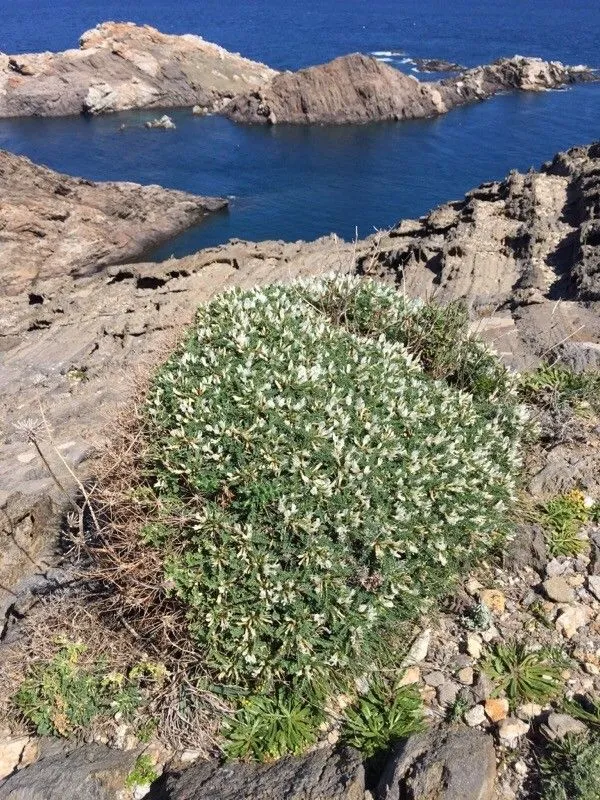
Author: L.
Bibliography: Sp. Pl.: 762 (1753)
Year: 1753
Status: accepted
Rank: species
Genus: Astragalus
Vegetable: Unknown
Observations: S. France to Iberian Pen.
Tragacanth, scientifically known as Astragalus tragacantha, is a remarkable plant belonging to the Fabaceae family, commonly known as the legume, pea, or bean family. This species was first described by the renowned botanist Carl Linnaeus in his seminal work, “Species Plantarum,” published in 1753.
Tragacanth is primarily found in the geographical range extending from Southern France to the Iberian Peninsula, showcasing its preference for Mediterranean climates. Known for its adaptability to arid and semi-arid environments, Astragalus tragacantha thrives in rocky and mountainous terrains, where it plays a crucial role in soil stabilization and erosion control.
The plant is particularly distinguished by its unique structural and physiological adaptations. It typically grows as a small, thorny shrub with dense, spiny branches. The leaves are pinnately compound, bearing numerous leaflets that often reduce water loss and enhance drought resistance. During its blooming period, Tragacanth produces clusters of small, yet striking flowers that range in color from white to pale pink, contributing to the biodiversity and aesthetic value of its native habitats.
One of the most notable aspects of Astragalus tragacantha is its production of a natural gum, commonly referred to as tragacanth gum. This gum has been historically significant, valued for its emulsifying, thickening, and stabilizing properties, which have widespread applications in the pharmaceutical, food, and cosmetic industries. Besides its commercial uses, the gum also illustrates the plant’s unique adaptation for moisture regulation and protection against harsh environmental conditions.
The presence of Tragacanth in ecosystems spanning Southern France to the Iberian Peninsula highlights its ecological importance and contributions to habitat diversity. This resilient species not only supports local biodiversity but also offers economic and cultural value through its useful derivatives.
Overall, Astragalus tragacantha stands as a prime example of botanical resilience and utility, demonstrating the intricate connections between plant adaptation, environmental interaction, and human utilization.
En: Tragacanth
Ar: قتاد أصغر
Ca: Coixí de monja, Eixorba-rates gros, Tragacant de Marsella
Cs: Kozinec
Fi: Kumikurjenherne
Fr: Astragale adragant, Astragale de Marseille, Coussin-de-belle-mère
It: Astragalo dragante
Ml: അസ്ട്രാഗാലസ് ട്രഗാകാന്ത
Taken Apr 1, 2018 by Daniel Barthelemy (cc-by-sa)
Taken May 6, 2003 by Tela Botanica − Liliane Roubaudi (cc-by-sa)
Taken Jul 1, 2010 by Alain Lagrave (cc-by-sa)
Taken Dec 3, 2021 by Llandrich anna (cc-by-sa)
Taken Apr 1, 2018 by Daniel Barthelemy (cc-by-sa)
Taken Feb 18, 2020 by Llandrich anna (cc-by-sa)
Taken Apr 1, 2018 by Daniel Barthelemy (cc-by-sa)
Taken Apr 13, 2019 by margarida vila (cc-by-sa)
Taken Apr 21, 2021 by anthony mazzuchelli (cc-by-sa)
Taken Apr 1, 2018 by Daniel Barthelemy (cc-by-sa)
Taken Jun 16, 2018 by Llandrich anna (cc-by-sa)
Taken Jun 2, 2018 by Tela Botanica − Genevieve BOTTI (cc-by-sa)
Taken Jun 2, 2018 by Tela Botanica − Genevieve BOTTI (cc-by-sa)
Taken Dec 3, 2021 by Llandrich anna (cc-by-sa)
© copyright of the Board of Trustees of the Royal Botanic Gardens, Kew.
© copyright of the Board of Trustees of the Royal Botanic Gardens, Kew.
© copyright of the Board of Trustees of the Royal Botanic Gardens, Kew.
Taken Apr 8, 2021 by Llandrich anna (cc-by-sa)
Taken Nov 27, 2017 by Llandrich anna (cc-by-sa)
Taken May 3, 2022 by desaunez Victor (cc-by-sa)
Taken Feb 18, 2020 by Llandrich anna (cc-by-sa)
Taken May 4, 2015 by Tela Botanica − Guillaume Sinquin (cc-by-sa)
Taken Apr 27, 2016 by Tela Botanica − Liliane ROUBAUDI (cc-by-sa)
Taken Apr 27, 2016 by Tela Botanica − Liliane ROUBAUDI (cc-by-sa)
Taken Feb 18, 2020 by Llandrich anna (cc-by-sa)
Taken Mar 4, 2015 by Tela Botanica − Geneviève Botti (cc-by-sa)
Taken Mar 26, 2011 by Tela Botanica − Liliane Roubaudi (cc-by-sa)
Taken Mar 26, 2011 by Tela Botanica − Liliane Roubaudi (cc-by-sa)
Taken Apr 25, 2016 by Tela Botanica − Genevieve BOTTI (cc-by-sa)
Taken Jun 21, 2015 by Tela Botanica − Errol VELA (cc-by-sa)
Taken Nov 30, 2021 by Sylvain Piry (cc-by-sa)
Family: Myrtaceae Author: (F.Muell.) K.D.Hill & L.A.S.Johnson Bibliography: Telopea 6: 402 (1995) Year: 1995 Status:…
Family: Rubiaceae Author: Pierre ex A.Froehner Bibliography: Notizbl. Bot. Gart. Berlin-Dahlem 1: 237 (1897) Year:…
Family: Sapindaceae Author: Koidz. Bibliography: J. Coll. Sci. Imp. Univ. Tokyo 32(1): 38 (1911) Year:…
Family: Asteraceae Author: A.Gray Bibliography: Pacif. Railr. Rep.: 107 (1857) Year: 1857 Status: accepted Rank:…
Family: Fabaceae Author: Medik. Bibliography: Vorles. Churpfälz. Phys.-Ökon. Ges. 2: 398 (1787) Year: 1787 Status:…
Family: Aspleniaceae Author: (Cav.) Alston Bibliography: Bull. Misc. Inform. Kew 1932: 309 (1932) Year: 1932…